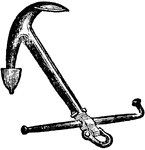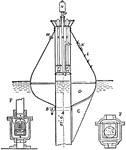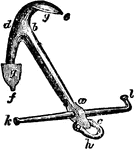Clipart tagged: ‘Shackle’

Admiralty's Anchor
"The Admiralty anchor differs only from the ordinary anchor in having a nut, a, worked on the square,…

Automatic Buoy
"Courtney's Automatic Buoy. A, cylinder, 27 ft. 6 in. long; B, mooring shackle; C, rudder; D, buoy;…

Bower Anchor
"A, is the cathead; B, the fish davit; C, and E, bollards; D, the bill-board. The anchor is held in…

Common Anchor
"The shank is the straight part, ab; the square, ac, is that part of the shank to which the stock and…

Martin's Anchor
"The anchor is represented in the position in which it lies on the ground just before taking hold. The…

Rodger's Anchor
"The stock is of iron in large as well as small anchors, and is made with a mortice, to fit over the…

Shackle Joint from the Exoskeleton of a Siluroid Fish
"A joint involving the principle of the shackle. Specifically, in anatomy, a kind of articulation found…

Trotman's Anchor
"The stock is of iron, similar to the Admiralty anchor; the shank is of rectangular section, somewhat…